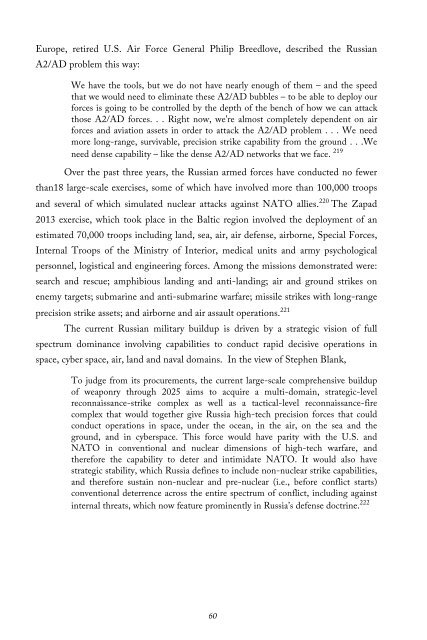Create successful ePaper yourself
Turn your PDF publications into a flip-book with our unique Google optimized e-Paper software.
Europe, retired U.S. Air Force General Philip Breedlove, described the Russian<br />
A2/AD problem this way:<br />
We have the tools, but we do not have nearly enough of them – and the speed<br />
that we would need to eliminate these A2/AD bubbles – to be able to deploy our<br />
forces is going to be controlled by the depth of the bench of how we can attack<br />
those A2/AD forces. . . Right now, we’re almost completely dependent on air<br />
forces and aviation assets in order to attack the A2/AD problem . . . We need<br />
more long-range, survivable, precision strike capability from the ground . . .We<br />
need dense capability – like the dense A2/AD networks that we face. 219<br />
Over the past three years, the Russian armed forces have conducted no fewer<br />
than18 large-scale exercises, some of which have involved more than 100,000 troops<br />
and several of which simulated nuclear attacks against NATO allies. 220 The Zapad<br />
2013 exercise, which took place in the Baltic region involved the deployment of an<br />
estimated 70,000 troops including land, sea, air, air defense, airborne, Special Forces,<br />
Internal Troops of the Ministry of Interior, medical units and army psychological<br />
personnel, logistical and engineering forces. Among the missions demonstrated were:<br />
search and rescue; amphibious landing and anti-landing; air and ground strikes on<br />
enemy targets; submarine and anti-submarine warfare; missile strikes with long-range<br />
precision strike assets; and airborne and air assault operations. 221<br />
The current Russian military buildup is driven by a strategic vision of full<br />
spectrum dominance involving capabilities to conduct rapid decisive operations in<br />
space, cyber space, air, land and naval domains. In the view of Stephen Blank,<br />
To judge from its procurements, the current large-scale comprehensive buildup<br />
of weaponry through 2025 aims to acquire a multi-domain, strategic-level<br />
reconnaissance-strike complex as well as a tactical-level reconnaissance-fire<br />
complex that would together give Russia high-tech precision forces that could<br />
conduct operations in space, under the ocean, in the air, on the sea and the<br />
ground, and in cyberspace. This force would have parity with the U.S. and<br />
NATO in conventional and nuclear dimensions of high-tech warfare, and<br />
therefore the capability to deter and intimidate NATO. It would also have<br />
strategic stability, which Russia defines to include non-nuclear strike capabilities,<br />
and therefore sustain non-nuclear and pre-nuclear (i.e., before conflict starts)<br />
conventional deterrence across the entire spectrum of conflict, including against<br />
internal threats, which now feature prominently in Russia’s defense doctrine. 222<br />
60



